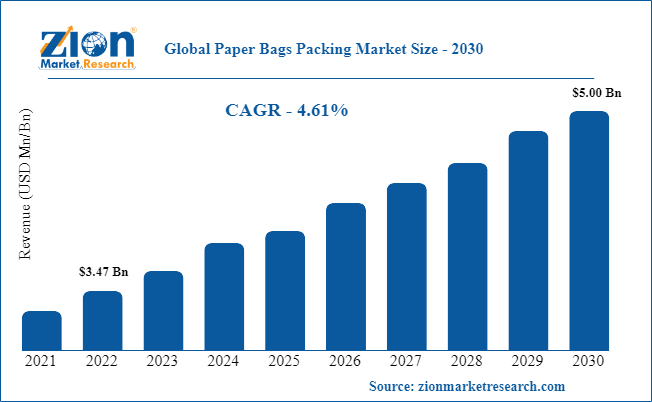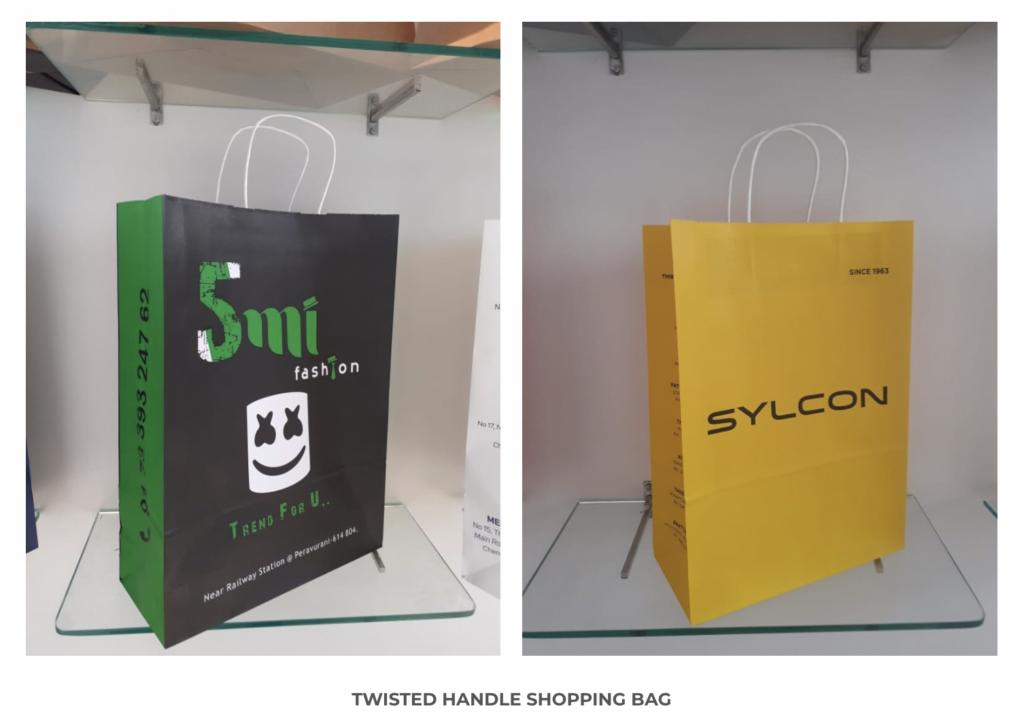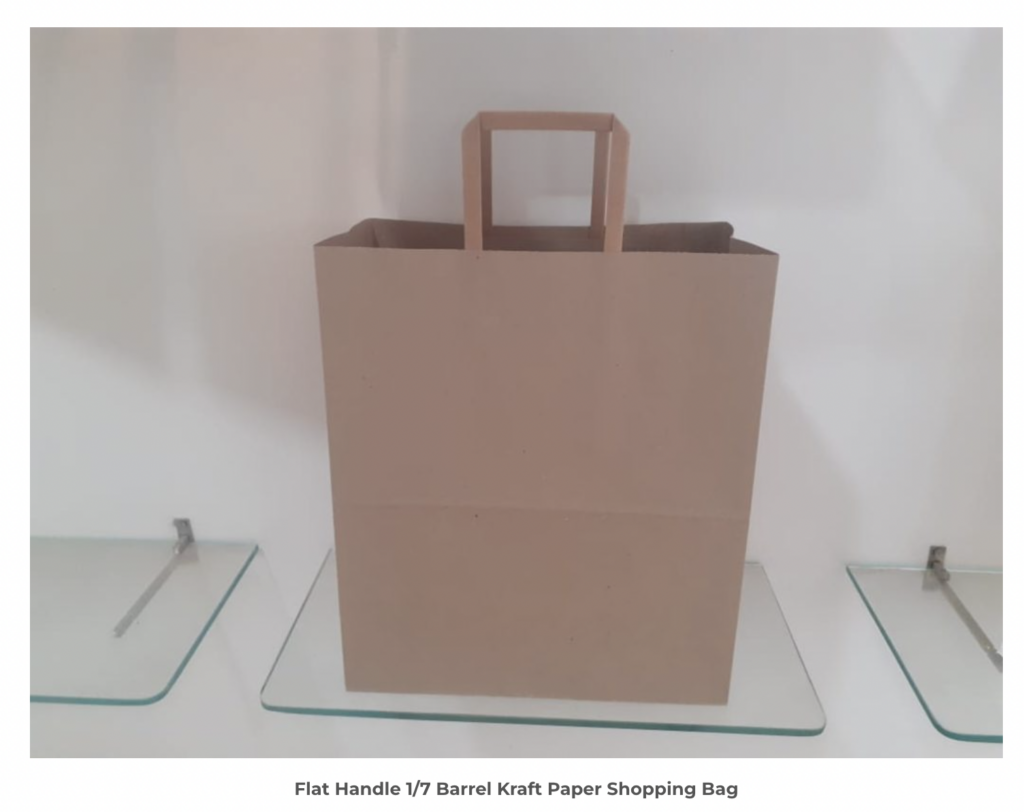The Paper bag production industry is growing exponentially each year. According to a report by Zion Market Research,
“The global paper bags packaging market size was worth around USD 3.47 Billion in 2022 and is predicted to grow to around USD 5 Billion by 2030 with a compound annual growth rate (CAGR) of roughly 4.61% between 2023 and 2030.”
Paper bags have become more prominent in daily purchases, with the world turning the wheel towards sustainable living and consumption. The ban on plastic in many countries across the globe has further fueled the need to ramp up the production of paper bags. The North American market is expected to be the largest market for paper bags, followed by Europe and Asia Pacific. Today, let’s understand more about paper shopping bags and meeting your business’s packaging needs.
What are Paper Shopping Bags?
Paper shopping bags, as the name suggests, are bags made out of paper commonly used to package day-to-day shopping items and carry them. The first paper bag was invented and made in 1852 by Francis Wolle and was originally intended as a hygienic alternative to cloth bags for carrying various shopping items such as flour, sugar, and more. These bags are typically made of sturdy, recycled, or virgin paper and have attached handles for a firm hold. The bags’ size, thickness, and holding capacity vary and come in many sizes. Reinforced bottoms or gussets are sometimes added to provide strength and stability to hold heavier items. A common sight at grocery stores, small business department stores, and more, paper shopping bags can be reused many times to carry items such as groceries, glass bottles, clothing, books, toiletries, etc.
What are Paper Bags Made of?
There are many types of paper bags, and the constituent material for paper bags might vary depending on the same. In the basic form, these bags are made from cellulose fibers that have been pulped and then pressed into sheets. The cellulose fibers can be derived from various sources, such as cotton, wood, or recycled paper.
What are the Types of Paper Bags?
There are many types of paper bags, each with varying holding capacities, sizes, and features. Some of the common paper shopping bags:
- Kraft brown bags
- SOS[Stand-on-Shelf] Bags
- Flat Bags
- Laminated paper bags
- Bakery bags
- Scotchban Bags
Kraft Brown Bags
Made of sturdy, durable material called Kraft paper, in the unbleached and natural form. These bags are noteworthy for their strength to carry heavier items and are long-lasting. Kraft Brown Bags are commonly used for grocery shopping and any general-purpose daily use.
SOS[Stand-On-Shelf] Bags
Stand on Shelf bags or SOS bags come with a gusseted design that enables them to stand and remain upright when opened. These bags are sometimes laminated with a polyethylene layer to make them waterproof and carry liquids.
Flat Bags
Flat bags usually don’t have handles or gussets and have simple construction to hold small, lightweight items.
Laminated Paper Bags
Laminated paper bags have a lamination layer added which makes them stronger, more durable, and liquid-proof to a large extent. These are used to carry liquids or items that need to reduce moisture exposure.
Bakery Bags
Bakery bags are specially designed to carry and store baked goods such as bread, pastries, cookies, and cakes and often come with grease-resistant paper to prevent contamination.
Scotchban Bags
These bags come with a special, water-repellent coating known as Scotchban. The intent of a Scotchban Bag is to provide a high degree of moisture protection, and these bags are particularly useful in damp environments or where susceptibility to liquid contamination is high.
How are Brown Paper Bags Different from White Bags?
There are many differences between brown and white paper bags. Let’s take a look at some of them.
- Source materials: Brown paper bags are usually manufactured using recycled sources, while white bags can be manufactured either from virgin content or recycled ones.
- Bleaching Process: The white bags are bleached to get the color, unlike brown paper bags, which retain their natural brown color.
- Strength & durability: Since brown paper bags are made of recycled paper, the strength and durability aren’t usually at par with white bags made from virgin pulp, a stronger raw material on its own.
- Environment-friendliness: Since brown bags are made of recycled materials, they are usually considered more environmentally friendly than white bags, which need fresh raw materials, and other resources for manufacturing.
What is the Capacity of Paper Shopping Bags?
The capacity of paper shopping bags can vary depending on their use. A standard grocery paper bag could have a capacity of 2-5 pounds, while a heavy-duty one may have a capacity of atleast 10 pounds. As we’ve already seen, reinforcements can be added to bags of varying sizes to increase their durability and strength.
Are Paper Bags Reusable?
Yes, paper bags are reusable and can be used multiple times before they wear out and tear. However, they are comparatively less durable than cloth bags and canvas bags. Some ways you can improve the longevity of your paper shopping bags are:
- Buy a good quality paper bag from trusted manufacturers and suppliers
- Fold and store the bags when not in use, preferably where water exposure is minimal.
- Avoid overloading the bag beyond its capacity.
Are Brown Grocery Bags Compostable?
Yes, most brown paper bags are compostable since they are made from natural sources such as cellulose fibers or wood pulp. It could take anywhere between 2-6 months for a paper bag to decompose. However, if the bag contains any reinforcements or plastic additives such as films, it needn’t be compostable.
Are Brown Paper Bags Recyclable?
Yes, brown paper bags are recyclable. In fact, most brown bags are made from recycled materials such as kraft paper.
Can you Place a Paper Bag in the Microwave?
No, it is not recommended generally to microwave your paper bag to be on the safe side. The high temperature in the microwave could cause the paper bag to ignite and cause a serious fire hazard. Also, in the case of some bags, the constituent materials in them can release toxic fumes when heated to such high temperatures. It’s best to transfer the bag’s contents to a microwave-safe container and then proceed to heat them.
Are Paper Bags Food-Safe?
Only paper bags that are certified food-safe must be used while handling food. This is because some bags are coated with plastic linings and reinforcing additives to increase durability. Many of these contents are not food-safe. Otherwise, paper bags don’t contain any harmful chemicals that can leach into food should they come in contact.
Paper Bags vs. Plastic Bags
How do paper bags fare compared to plastic bags? Let’s compare the two on various aspects ranging from environment-friendliness to cost.
- Environmental friendliness: Paper bags are friendlier to the environment since it is manufactured from biodegradable materials such as wood pulp. However, these must be reused multiple times and recycled to truly make a positive impact on the environment. Plastic bags must be recycled to reduce their harmful effects on the environment.
- Cost: Paper bags are more expensive than plastic bags due to the raw materials involved, the manufacturing process, and more.
- Strength: While paper bags come with a fixed capacity, overloading, which can cause them to tear, plastic bags fare better in terms of strength and can carry loads slightly over their capacity.
- Durability: Paper bags are more prone to tear & damage than plastic bags, especially when overloaded and handled without care.
- Decomposition: While plastic bags can take years, at times decades or more, to decompose, paper bags only take a few months to decompose.
- Source materials: Paper bags are commonly made from wood pulp which is derived from renewable energy sources, while raw materials for plastic bags are derived from petroleum which is a non-renewable resource.
What are the Disadvantages of Paper Bags?
Although paper bags have many benefits, as we have seen above, there are also many drawbacks.
- Paper bags are more susceptible to tear & damage than cloth, canvas, or plastic bags.
- Unless paper bags are stored with care, they aren’t durable compared to other bags.
- Even though the fundamental raw material for paper bags, wood pulp, is derived from renewable resources, a lot of water & energy is used for their production. Considering this, paper bags aren’t the best environment-friendly alternative to plastic bags.
RedibagUSA: The Best Paper Bag Manufacturers & Suppliers
Getting your paper bags, be it for your business or personal use, from trusted manufacturers is necessary to ensure they meet the expected quality standards and last longer. At RedibagUSA, we take pride in ensuring our paper shopping bags meet this easily. Our goal is to help customers like you get the right packaging products for their business needs, ensure a continuous supply of products, and finally do right by the environment with a wide array of recycled content bags.
Our capabilities include:
- Standard unprinted Kraft Paper Shopping bags in truckload quantities.
- High-end shopping bags featuring graphics, coatings, and rope handles. These bags are a go-to option for our current customers in the cosmetics supply, electronics stores, and fashion boutiques sectors.
- Food Take-Out Bags for restaurants.
- Bread bags with grease-resistant options.
Rely on the Experience
With a complete and diversified selection of products, RediBagUSA is the company you were searching for. We handle the production, distribution, and logistics capabilities to serve some of the world’s largest international supermarkets and quick-service restaurants.
Contact us for more information about our offer and how we can satisfy your every packaging need!



